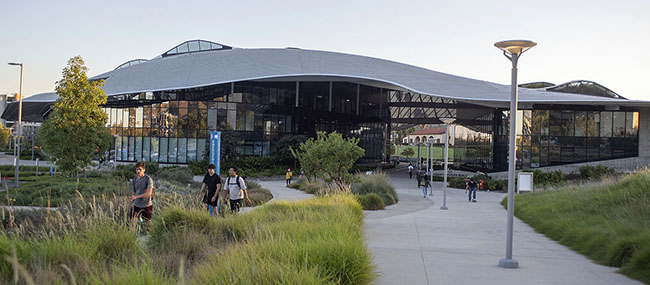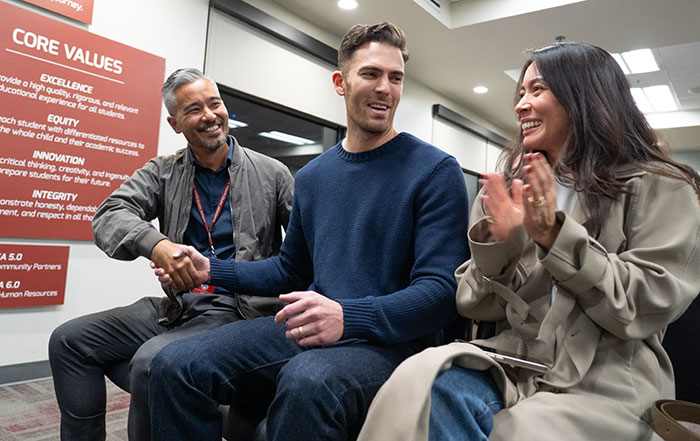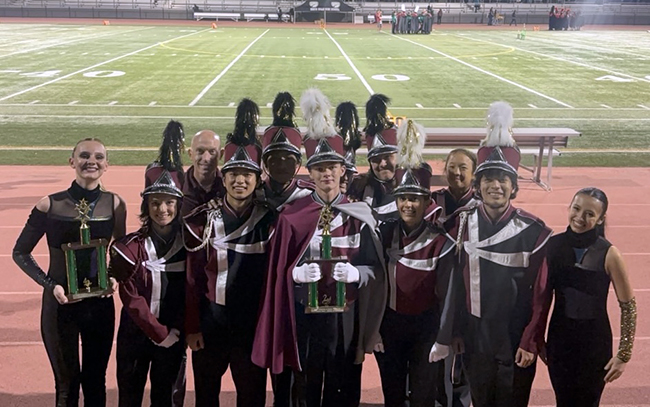COURIER special: CUSD board candidate Q&A
Claremont Unified School District board member Hilary LaConte, Claremont resident Joe Farrell and former board member Sam Mowbray are the 3 candidates who are vying for the 2 open seats on the CUSD school board this fall. The road to November 8th is officially starting this month with all 3 candidates hosting their campaign kick-off parties and participating in their first candidate forums.
The candidates will also use the next 2 months to garner support before Election Day. As the candidates begin their campaigns, the COURIER interviewed each of the candidates to get their thoughts on some of the major issues affecting CUSD.
Joe Farrell
Claremont resident Joe Farrell wants to make an impact on Claremont Unified School District schools.
The former school board member and president of the Town of Marlborough School District is seeking his first term as a member of the CUSD school board this fall. The election will take place on November 8th.
As a board member on 2 boards of education in Connecticut, Mr. Farrell negotiated union agreements with teachers, office and professional staff, custodians and administrators. He also headed district committees that l
ed to the hire of superintendents, special education directors, principals and assistant principals.
Mr. Farrell earned a Bachelor of Arts in international relations from the University of Southern California in 1981 before going on to graduate from Pepperdine University’s School of Law in 1985. From there, the attorney was admitted to the California State Bar (1985), Connecticut State Bar (1993) and the United States Supreme Court (1995).
Since Mr. Farrell moved to Claremont in August 2010, he has been a regular attendee at CUSD board meetings and has been outspoken about the current direction of the district and board policies. He was part of the Claremont Taxpayers for Common Sense campaign that led to the rejection of a proposed $95 million Measure CL bond measure in November 2010.
What do you feel is the most important area of focus for the district going forward?
Mr. Farrell: Student achievement is the biggest priority followed by a transparent operation. If somebod
y asks a question, they should be able to get an answer with any information the district has. They shouldn’t have to ask twice. They shouldn’t have to follow up, either. The most important thing a board member needs to know is, why.
And the other thing that concerns me is that there is no discussion at the board level or the administration of how to take score improvement, how to take proven instruction and move it through the district. It seems like every school is allowed to operate like a separate operation without ensuring that all the 6th graders in all the classes will know the same thing when they leave. Good ideas and good instruction should get spread throughout the district.
What do you feel is the best way to raise the remainder of the $1.5 million needed for the CHS Theatre renovation?
Mr. Farrell: They could raise that money tomorrow and dedicate it to the project. They just declared around 4 acres of [the property at Mountain Avenue and Base Line] surplus and it’s worth at least $1.5 million in Claremont, even in the current real estate market. How I would do it at this point is have a meeting almost immediately. I would use a bond or find some way to borrow the $1.5 million using the existing surplus assets. It would cost the district zero, and we’d have the money in 30 to 90 days.
The example I’ve been giving people is that you take a person who discovers he needs a new roof on his house. And there’s an extra car sitting in the driveway. Instead of selling the car to generate the money to put the roof on, what the district is doing is letting their neighbor have yard sales and sell lemonade to raise $100 a week and hope that they will raise enough money.
Do you feel CUSD ultimately benefits or suffers from the amount of transfers it has?
Mr. Farrell: You need to ask the community that question but if you’re going to ask the question, then you need to have some answers. Those answers include the total number, where they are and then the cost of operating wherever they are. You need to look at the total size of the district, what the schools would look like without the interdistrict transfers, what the recommendation of the administration would be, which schools would still exist and if they all still exist what the size would be.
What does it cost to have those students attend our schools? And at 1400 individuals, how many administrators are we hiring for those people? How many teachers do we have? How many extra custodians do we have? And the number goes on and on and on as to what the incremental cost is for those students. If you don’t know that, you don’t know if they’re helping to keep our school doors open.
What are your thoughts on No Child Left Behind? Do you support State Superintendent Tom Torlakson’s recent request to freeze NCLB sanctions against California schools?
Mr. Farrell: No Child Left Behind is a great idea. The idea is to raise student performance, recognize when it happens, recognize when it doesn’t and have some consequence to it. [But] No Child Left Behind needs to be amended.
Superintendent Torlakson wants to get a waiver. But that doesn’t do anything for the kids who are still failing. So you have a piece of paper that says you’re not failing anymore but what does that do for the kids who still are failing? I am a strong believer that schools need to be measured based on how they’re improving performance, not about what they’re not doing. The purpose of NCLB was to improve schools. Shouldn’t we be measuring improvement?”
Hilary LaConte
Claremont Unified School District board member Hilary LaConte believes she has much more to give to benefit Claremont education.
Originally elected as a board member in 2007, Ms. LaConte is the only incumbent in this year’s school board race. The election will take place on Tuesday, November 8th.
Ms. LaConte has a long history with CUSD. She attended Vista del Valle Elementary School, El Roble Intermediate School and Claremont High School as a student. After earning her Bachelor of Arts in organizational communication and communication disorders from California State University, Stanislaus, she went on to receive her Master in Arts in education and Ryan Clear Credential from Claremont Graduate University in 1989.
The same year Ms. LaConte earned her master’s degree was the year she began teaching in CUSD. She taught at Vista del Valle from 1989 to 1995 before serving as an adjunct associate professor at Chaffey Community College (1996-98) and Claremont Graduate University (1991-2001).
Ms. LaConte is also a parent in CUSD with sons currently attending El Roble and CHS. She maintains an active role in community organizations such as the Claremont High School Theatre Renovation Committee, Curtain Raisers of the Claremont Colleges, Uncommon Good, Claremont Community Coordinating Council, League of Women Voters and University Club.
Why are you running for a 2nd term with the CUSD board?
Ms. LaConte: My motivation is fourfold. First, I have been encouraged to seek re-election by many community members, parents and students. Second, I want to provide continuity in leadership. We’ve hired 4 new principals and will hire a superintendent. Over the last month, we’ve begun the process of working with the broader community to redefine our vision, mission, core values, and strategic goals. The outcomes of this process will continue to drive the direction of the district over the next few years.
Third, I am sensitive to the fact that state revenue is uncertain. It is likely that we will see further reduction in revenue, which will mean difficult decisions ahead. I think my teaching, parent and long-term community perspectives will be helpful. I continue to be concerned about the funding of public schools. Claremont Unified works to be as fiscally conservative as possible and we’ve had support in these efforts from our staff district-wide.
And finally, I am deeply committed to our community and our school district and want to help guide the decisions that affect us all.”
What are your thoughts on No Child Left Behind? Do you support State Superintendent Tom Torlakson’s recent request to freeze NCLB sanctions against California schools?
Ms. LaConte: The pros are that it has forced school districts to hire highly qualified teachers. The focus on core standards, the focus on curriculum is a good focus. It has kind of forced districts, including Claremont, to focus on what we’re teaching, how we’re teaching it, making sure that every child is getting the information that they need. Those are positives.
The negatives are the sanctions. Because even though a school makes tremendous growth in a content area, if you don’t make enough growth, you get penalized. And I don’t think that is particularly helpful. So I think that freezing the sanctions is a good idea. I think it will give all the school districts time to catch their breath and continue to focus on improvement without having that panicked feeling.
When you focus so much on trying to avoid the sanctions, it narrows the curriculum so that you’re only teaching very specific things on the test. You’re letting a lot of other things go.
What do you feel is the best way to raise the remainder of the $1.5 million needed for the CHS Theatre renovation?
Ms. LaConte: The community is working really hard and I’m proud to be involved in this project. We’ve had a fabulous participation from so many people in Claremont. The community has responded fabulously but we’re going to need a lot more money. I would love to see someone or 2 people put up a challenge grant—a challenge opportunity to the community for around half a million dollars and say, ‘Okay Claremont community, let’s rally together and match this.’
Another way is to consider options for the property at Base Line Road and Mountain Avenue. The board has not had public discussion on this but it’s something to explore if by chance we don’t raise enough money.
Do you feel CUSD ultimately benefits or suffers from the amount of transfers it has?
Ms. LaConte: Whether they are from within our school district boundaries or from without, each student brings the same revenue. There is a long-term practice of accepting interdistrict students and ongoing conversation about the benefits, both financial and otherwise. My understanding from the past and current district staff and superintendents is that there is positive financial gain overall from accepting interdistrict students. There is room, of course, for continued study and analysis and I am open to that conversation.
Sam Mowbray
Claremont resident Sam Mowbray concluded an impressive 3-term stint on the Claremont Unified School District board in 2005. But the former board member is now seeking his 4th term in 2011.
Mr. Mowbray now wants to help the district navigate its current transitional period as he vies for one of 2 seats in the 2011 board election. The election will take place on November 8th.
A Claremont resident since 1980, Mr. Mowbray has served on several committees and remains an active member of the community. His participation has included membership on the Greater Pomona Valley Housing Development Corporation, Los Angeles County School for the Arts and CUSD boards.
During Mr. Mowbray’s former school board tenure from 1993-2005, he co-founded EdNet (now known as the Claremont Educational Foundation) and also served as the president of the Los Angeles County School Trustees Association. The 12-year period also included passage of the $48.9 million Measure Y bond measure (2000) and the successful Save Our Schools campaign (2004) that raised $600,000 over several months to combat class size increases.
Mr. Mowbray earned his bachelor’s degree and Ph.D. from UCLA in micro/molecular biology before moving on to serve as assistant professor at Smith College and as a research professor at UCLA. The former board member spent 15 years working in product development at Johnson & Johnson and was a laboratory manager at the Orange County Sanitation District until his retirement a few years ago.
What do you feel is the most important area of focus for the district going forward?
Mr. Mowbray: I think managing the district, keeping focus on the classroom and trying to figure out how in the world we find additional money are going to be the major issues. That’s going to require a tremendous amount of negotiations with the professional staff of the school district—particularly the teachers. Eighty-five percent of the budget is in salaries and benefits for the teaching staff. And so, the only place you have left to get money to keep schools operating without going to very large class sizes and getting rid of teachers is going back to the unions and saying, ‘what can we collectively do?’
What are your thoughts on No Child Left Behind? Do you support State Superintendent Tom Torlakson’s recent request to freeze NCLB sanctions against California schools?
Mr. Mowbray: “I think No Child Left Behind as a philosophy is a good thing. It can almost be a vision that we’re not going to customize education programs around the favored few. We’re going to educate everybody and that’s what that really was all about.
I think that the evaluations of the No Child Left Behind progress are wrong because they’re based on percentages. So schools that have a long way to go easily met their requirements. We did early on. And now as you get closer to whatever the measurement milestone is, it gets more difficult. The issue of how we measure these things needs to be addressed and I think the whole thing should be evaluated.
What do you feel is the best way to raise the remainder of the $1.5 million needed for the CHS Theatre renovation?
Mr. Mowbray: I think that since the grant was given to the district, not to the renovation committee, that the district and the school board need to seriously consider other mechanisms of securing that $1.5 million grant. And there are several mechanisms that are available. I personally think that any capital expenditure should be used as capital. It should not be used as one-time operating money because once it’s used as one-time operating money it’s gone.
In particular, with the Base?Line Road property, if we can sell it that’s even better and we can use that money for capital and reinvest in the theatre. But even if we don’t sell it, it’s still collateral for a loan and the school district has the capacity to borrow money. We have a $1.5 million grant from the state and we need to do everything we can to secure that.
Do you feel CUSD ultimately benefits or suffers from the amount of transfers it has?
Mr. Mowbray: It depends on how you value things. One of the major values in an interdistrict transfer is that it allows us to keep the neighborhood schools open. We have 3 small schools right now and if those schools were to lose attendance, we would have to close one of them or raise the money from some other source to keep it open.
And then there are small schools, which are not nearly as efficient in the educational process. In some instances you have one teacher per grade level rather than 3 teachers. And so the synergy that occurs between the teacher and the amount they learn from each other is very valuable. So we don’t want schools that are smaller than 250 to 300 students.
I think right now, interdistrict transfers are a good thing.
—Landus Rigsby












0 Comments